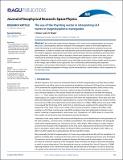The use of the Poynting vector in interpreting ULF waves in magnetospheric waveguides
Abstract
We numerically model ultralow frequency (ULF) waves in the magnetosphere assuming an ideal, low-beta inhomogeneous plasma waveguide. The waveguide is based on the hydromagnetic box model. We develop a novel boundary condition that drives the magnetospheric boundary by pressure perturbations, in order to simulate solar wind dynamic pressure uctuations disturbing the magnetopause. The model is applied to observations from Cluster and THEMIS. Our model is able to reproduce similar wave signatures to those in the data, such as a unidirectional azimuthal Poynting vector, by interpreting the observations in terms of fast waveguide modes. Despite the simplicity of the model, we can shed light on the nature of these modes and the location of the energy source relative to the spacecraft. This is achieved by demonstrating that important information, such as phase shifts between components of the electric and magnetic fields and the balance of radial to azimuthal propagation of energy, may be extracted from a careful analysis of the components of the Poynting vector.
Citation
Elsden , T & Wright , A N 2015 , ' The use of the Poynting vector in interpreting ULF waves in magnetospheric waveguides ' , Journal of Geophysical Research: Space Physics , vol. 120 , no. 1 , pp. 166-186 . https://doi.org/10.1002/2014JA020748
Publication
Journal of Geophysical Research: Space Physics
Status
Peer reviewed
ISSN
2169-9402Type
Journal article
Description
T.E. would like to thank STFC for financial support for a doctoral training grant. Date of Acceptance: 04/12/2014Collections
Items in the St Andrews Research Repository are protected by copyright, with all rights reserved, unless otherwise indicated.

